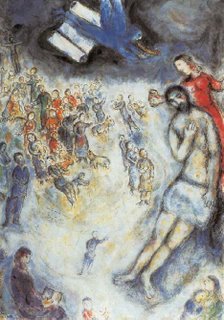Job with Background of Geometricized Christ à la Cimabuë by Marc ChagallMany have pointed to Job as a prefigurement of Christ in the tradition of the Suffering Servant of Isaiah. Chagall captures this beyond literary expression. His artistic engagement with Job came late in his work and it may be that he had turned away from the figure of Job until the revelations of the Holocaust compelled him to face not only the scandal of a gigantic evil in the world but also the subtle complex of faith and the revolt within the human soul. This piece was painted ten years before his death and is itself a stark reminder of Christianity’s inseparability from Israel--something Chagall called Christianity to account for throughout his career.
This is the last in a series of Joban interpretations. It was painted in 1975, about ten years before Chagall’s death. Chagall, as a Jew, understood what a Christian theology of suffering should look like better than some Christian theologians do. What he so boldly realizes is that in considering the reality of suffering and the reality of Job’s God, we cannot speak of, or more properly visualize, suffering apart from the suffering God found in the narratives of the New Testament.
In this Joban interpretation, suffering abounds. Job the sufferer stands up close as the Jewish peasants—fathers, mothers, infants, and children—look to him with both lament and hope. Job’s wife is given a prominent role which, we should note, is an extrapolation from the text itself. This is because of the strong role of women in his own life. In a sense, he’s rescuing her identity from the obscurity it has in the narrative. It is actually a Marian interpretation, a suggestion of the suffering of the mother of Jesus. Directly opposite Job rests the Crucified one. He is faint in the distance, an echo of the Joban drama directly before us. The crowd in the background are similarly involved as those in the foreground. They look to Christ as they do to Job—with expectation. The angelic messenger, with open scroll, is suspended above both dramas demonstrating the Divine presence over both narratives. The unity of the drama is undeniable. The light of the angel contrasts with the darkness surrounding Golgotha. Yet the light is not eclipsed by the darkness, nor the darkness totally eclipsed by the light (I am indebted to Samuel Terrien's wonderful meditation upon this painting in his The Iconography of Job Through the Centuries, Penn State Press, 1996).
The Joban narrative points us to the drama of the One who suffers pro nobis, for us. Chagall brilliantly depicts this. It is in witnessing to the suffering servant of YHWH narrated in the gospels that the book of Job finds its true place. Ours is the same drama. We suffer and bemoan, lament and curse, and legitimately so. We plead for a response. We are indeed surprised that we have been engaged “out of the whirlwind” and our transformation results in our faithful and trustful acceptance of and obedience to the One who speaks. The one who rules from a cross. Our theology and language of suffering ought to begin here as, like Job, we lay our hands over our mouths and yet are driven to speak: “We had heard of you by the hearing of the ear, but now our eyes see you.”

No comments:
Post a Comment